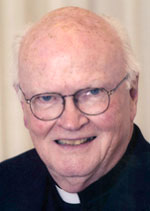The words are so familiar and we say them so often that we owe it to ourselves to reflect on their deeper meaning. “In the name of the Father, and of the Son, and of the Holy Spirit.”
The words are said as the fingers of the right hand touch the forehead, move to the sternum or breastbone, and then cross from the left to right shoulder of the believer seeking God’s blessing or initiating an experience of personal or communal prayer.
The descent of the right hand suggests the incarnational descent of the Second Person of the Trinity; the crossover from left shoulder to right suggests the movement of the Holy Trinity in our world.
The sign of the cross is there at the beginning of Mass. It introduces “grace” before meals. It initiates one’s entrance into the sacrament of reconciliation. It sets one apart momentarily from the distractions of daily life for the experience of quiet prayer.
Even when done hastily, perhaps casually and without much thought, the sign of the cross has special meaning for the believer.
[hotblock]
One dimension of that meaning is the reminder that another body, not yours, hung on that cross on Calvary. Now, centuries removed as we are from that event, we can recall that we are called to walk the Way of the Cross in our own day, in our own corner of the world.
We are called to participate in the repair work Jesus initiated, the work of reparation for sin. What Paul said to the Galatians (2:19) applies to us: “I have been crucified with Christ; yet I live, no longer I, but Christ lives in me.”
When you trace it on your own body, the sign of the cross serves to remind that you too are crucified; you too hang there. By the grace of the living Christ, you hang there with him now for the salvation of the world.
The crucifix that we display in our homes is there not as artwork to be admired; it is there to serve as a reminder of God’s love. The difference between the cross and the crucifix is the corpus — the body attached to the cross.
That dead body rose again so that we might have life. We are not embarrassed by the spectacle of a bruised body — brutally beaten and hanging in death — wearing only a loin cloth and exposed in full view. We are not embarrassed; we are profoundly grateful.
The crucifix says so much more than the cross. It says death on the way to resurrection.
By the crucifixion, Jesus literally poured out his blood and last breath for us. We will not experience the suffering he experienced.
But each of us, in the circumstances of his or her own life, will experience some suffering that, in faith, we can unite with his for the salvation of the world. All the more reason to make the sign of the cross something more than a flea-flicking gesture.
***
Jesuit Father Byron is university professor of business and society at St. Joseph’s University, Philadelphia. Email: wbyron@sju.edu.
PREVIOUS: Eternal happiness without one’s children?
NEXT: If you leave church before Mass is over, does it ‘count’?




Share this story